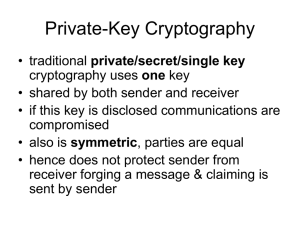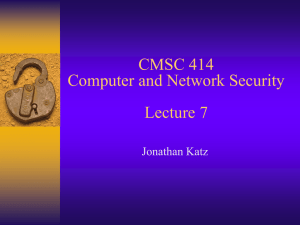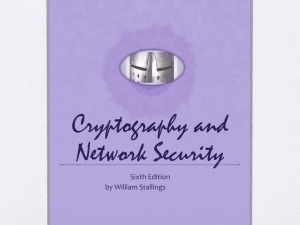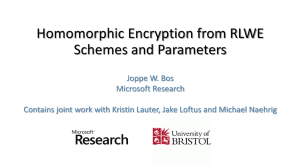Public Key Cryptography and RSA
advertisement
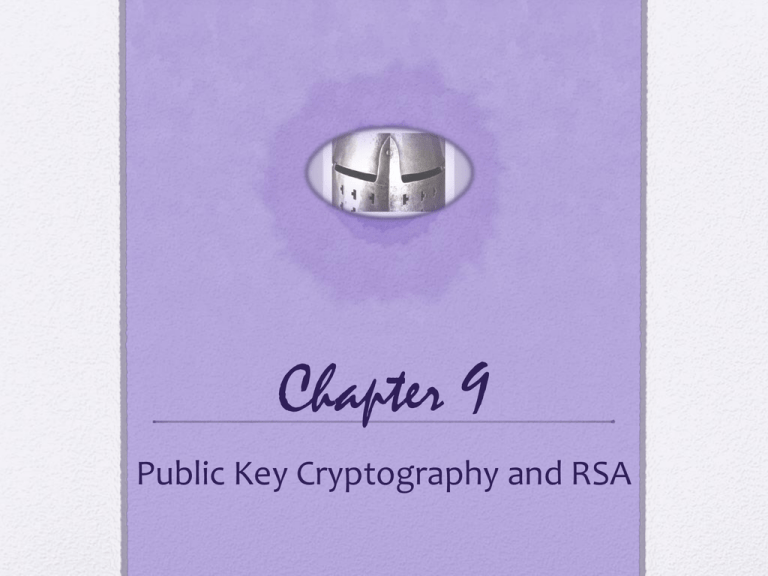
Chapter 9
Public Key Cryptography and RSA
Misconceptions Concerning
Public-Key Encryption
• Public-key encryption is more secure from
cryptanalysis than symmetric encryption
• Public-key encryption is a general-purpose
technique that has made symmetric encryption
obsolete
• There is a feeling that key distribution is trivial
when using public-key encryption, compared to
the cumbersome handshaking involved with key
distribution centers for symmetric encryption
Table 9.1
Terminology Related to Asymmetric Encryption
Source: Glossary of Key Information Security Terms, NIST IR 7298 [KISS06]
Principles of Public-Key
Cryptosystems
• The concept of public-key cryptography evolved from
an attempt to attack two of the most difficult
problems associated with symmetric encryption:
Key distribution
• How to have secure communications in general without having to
trust a KDC with your key
Digital signatures
• How to verify that a message comes intact from the claimed sender
• Whitfield Diffie and Martin Hellman from Stanford
University achieved a breakthrough in 1976 by coming
up with a method that addressed both problems and
was radically different from all previous approaches to
cryptography
Public-Key Cryptosystems
• A public-key encryption scheme has six ingredients:
Plaintext
The
readable
message
or data
that is fed
into the
algorithm
as input
Encryption
algorithm
Performs
various
transformations on
the
plaintext
Public key
Used for
encryptio
n or
decryptio
n
Private key
Used for
encryptio
n or
decryptio
n
Ciphertext
Decryption
algorithm
The
scrambled
message
produced
as output
Accepts
the
ciphertext
and the
matching
key and
produces
the
original
plaintext
Public-Key
Cryptography
Table 9.2
Conventional and Public-Key Encryption
Public-Key Cryptosystem: Secrecy
Public-Key Cryptosystem: Authentication
Public-Key Cryptosystem:
Authentication and Secrecy
Applications for Public-Key
Cryptosystems
• Public-key cryptosystems can be classified into
three categories:
•The sender encrypts a message
Encryption/decryption
with the recipient’s public key
Digital signature
Key exchange
•The sender “signs” a message
with its private key
•Two sides cooperate to
exchange a session key
• Some algorithms are suitable for all three
applications, whereas others can be used only for
one or two
Table 9.3
Applications for Public-Key Cryptosystems
Table 9.3 Applications for Public-Key Cryptosystems
Public-Key Requirements
• Conditions that these algorithms must fulfill:
• It is computationally easy for a party B to generate a pair
(public-key PUb, private key PRb)
• It is computationally easy for a sender A, knowing the
public key and the message to be encrypted, to generate
the corresponding ciphertext
• It is computationally easy for the receiver B to decrypt
the resulting ciphertext using the private key to recover
the original message
• It is computationally infeasible for an adversary, knowing
the public key, to determine the private key
• It is computationally infeasible for an adversary, knowing
the public key and a ciphertext, to recover the original
message
• The two keys can be applied in either order
Public-Key Requirements
• Need a trap-door one-way function
• A one-way function is one that maps a domain into a range
such that every function value has a unique inverse, with the
condition that the calculation of the function is easy, whereas
the calculation of the inverse is infeasible
• Y = f(X) easy
• X = f–1(Y) infeasible
• A trap-door one-way function is a family of invertible
functions fk, such that
• Y = fk(X) easy, if k and X are known
• X = fk–1(Y) easy, if k and Y are known
• X = fk–1(Y) infeasible, if Y known but k not known
• A practical public-key scheme depends on a suitable trapdoor one-way function
Public-Key Cryptanalysis
• A public-key encryption scheme is vulnerable to a brute-force
attack
• Countermeasure: use large keys
• Key size must be small enough for practical encryption and
decryption
• Key sizes that have been proposed result in encryption/decryption
speeds that are too slow for general-purpose use
• Public-key encryption is currently confined to key management and
signature applications
• Another form of attack is to find some way to compute the
private key given the public key
• To date it has not been mathematically proven that this form of
attack is infeasible for a particular public-key algorithm
• Finally, there is a probable-message attack
• This attack can be thwarted by appending some random
bits to simple messages
Rivest-Shamir-Adleman
(RSA) Scheme
• Developed in 1977 at MIT by Ron Rivest, Adi
Shamir & Len Adleman
• Most widely used general-purpose approach
to public-key encryption
• Is a cipher in which the plaintext and
ciphertext are integers between 0 and n – 1 for
some n
• A typical size for n is 1024 bits, or 309 decimal
digits
RSA Algorithm
• RSA makes use of an expression with exponentials
• Plaintext is encrypted in blocks with each block having a binary
value less than some number n
• Encryption and decryption are of the following form, for some
plaintext block M and ciphertext block C
C = Me mod n
M = Cd mod n = (Me)d mod n = Med mod n
• Both sender and receiver must know the value of n
• The sender knows the value of e, and only the receiver knows the
value of d
• This is a public-key encryption algorithm with a public key of
PU={e,n} and a private key of PR={d,n}
Algorithm Requirements
• For this algorithm to be satisfactory for publickey encryption, the following requirements
must be met:
1. It is possible to find values of e, d, n
such that Med mod n = M for all M < n
2. It is relatively easy to calculate Me mod
n and Cd mod n for all values of M < n
3. It is infeasible to determine d given e
and n
Example of RSA Algorithm
Exponentiation in Modular
Arithmetic
• Both encryption and decryption in RSA involve
raising an integer to an integer power, mod n
• Can make use of a property of modular
arithmetic:
[(a mod n) x (b mod n)] mod n =(a x b) mod n
• With RSA you are dealing with potentially large
exponents so efficiency of exponentiation is a
consideration
Table 9.4
Efficient Operation Using
the Public Key
• To speed up the operation of the RSA
algorithm using the public key, a specific
choice of e is usually made
• The most common choice is 65537 (216 + 1)
• Two other popular choices are e=3 and e=17
• Each of these choices has only two 1 bits, so the
number of multiplications required to perform
exponentiation is minimized
• With a very small public key, such as e = 3, RSA
becomes vulnerable to a simple attack
Efficient Operation Using
the Private Key
• Decryption uses exponentiation to power d
• A small value of d is vulnerable to a brute-force
attack and to other forms of cryptanalysis
• Can use the Chinese Remainder Theorem
(CRT) to speed up computation
• The quantities d mod (p – 1) and d mod (q – 1)
can be precalculated
• End result is that the calculation is
approximately four times as fast as evaluating
M = Cd mod n directly
Key Generation
• Before the application of
the public-key
cryptosystem each
participant must
generate a pair of keys:
• Determine two prime
numbers p and q
• Select either e or d and
calculate the other
• Because the value of n = pq
will be known to any
potential adversary, primes
must be chosen from a
sufficiently large set
• The method used for
finding large primes must
be reasonably efficient
Procedure for Picking a
Prime Number
• Pick an odd integer n at random
• Pick an integer a < n at random
• Perform the probabilistic primality test with a
as a parameter. If n fails the test, reject the
value n and go to step 1
• If n has passed a sufficient number of tests,
accept n; otherwise, go to step 2
The Security of RSA
Brute force
Chosen ciphertext
attacks
• This type of attack
exploits properties
of the RSA
algorithm
Hardware fault-based
attack
• This involves inducing
hardware faults in the
processor that is
generating digital
signatures
• Involves
trying all
possible
private keys
Five
possible
approaches
to
attacking
RSA are:
Mathematical attacks
• There are several
approaches, all
equivalent in effort to
factoring the product
of two primes
Timing attacks
• These depend on the
running time of the
decryption
algorithm
Factoring Problem
• We can identify three approaches to attacking
RSA mathematically:
• Factor n into its two prime factors. This enables
calculation of ø(n) = (p – 1) x (q – 1), which in
turn enables determination of d = e-1 (mod ø(n))
• Determine ø(n) directly without first
determining p and q. Again this enables
determination of d = e-1 (mod ø(n))
• Determine d directly without first determining
ø(n)
T
a 9
b .
l 5
e
Table 9.5 Progress in RSA Factorization
MIPS-Years
Needed
to
Factor
Timing Attacks
• Paul Kocher, a cryptographic consultant,
demonstrated that a snooper can determine a
private key by keeping track of how long a
computer takes to decipher messages
• Are applicable not just to RSA but to other
public-key cryptography systems
• Are alarming for two reasons:
• It comes from a completely unexpected
direction
• It is a ciphertext-only attack
Countermeasures
Constant
exponentiation time
•Ensure that all
exponentiations take the
same amount of time
before returning a result;
this is a simple fix but does
degrade performance
Random delay
Blinding
•Better performance could
be achieved by adding a
random delay to the
exponentiation algorithm
to confuse the timing
attack
•Multiply the ciphertext by
a random number before
performing
exponentiation; this
process prevents the
attacker from knowing
what ciphertext bits are
being processed inside the
computer and therefore
prevents the bit-by-bit
analysis essential to the
timing attack
Fault-Based Attack
• An attack on a processor that is generating RSA digital
signatures
• Induces faults in the signature computation by reducing the
power to the processor
• The faults cause the software to produce invalid signatures
which can then be analyzed by the attacker to recover the
private key
• The attack algorithm involves inducing single-bit errors and
observing the results
• While worthy of consideration, this attack does not appear
to be a serious threat to RSA
• It requires that the attacker have physical access to the target
machine and is able to directly control the input power to the
processor
Chosen Ciphertext Attack
(CCA)
• The adversary chooses a number of ciphertexts and is
then given the corresponding plaintexts, decrypted
with the target’s private key
• Thus the adversary could select a plaintext, encrypt it
with the target’s public key, and then be able to get the
plaintext back by having it decrypted with the private
key
• The adversary exploits properties of RSA and selects
blocks of data that, when processed using the target’s
private key, yield information needed for cryptanalysis
• To counter such attacks, RSA Security Inc.
recommends modifying the plaintext using a
procedure known as optimal asymmetric encryption
padding (OAEP)
Optimal
Asymmetric
Encryption
Padding
(OAEP)
Summary
• Public-key
cryptosystems
• Applications for publickey cryptosystems
• Requirements for
public-key
cryptography
• Public-key cryptanalysis
• The RSA algorithm
• Description of the
algorithm
• Computational
aspects
• Security of RSA
